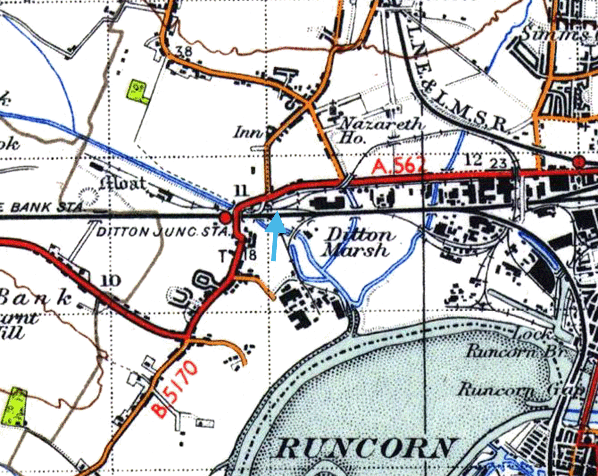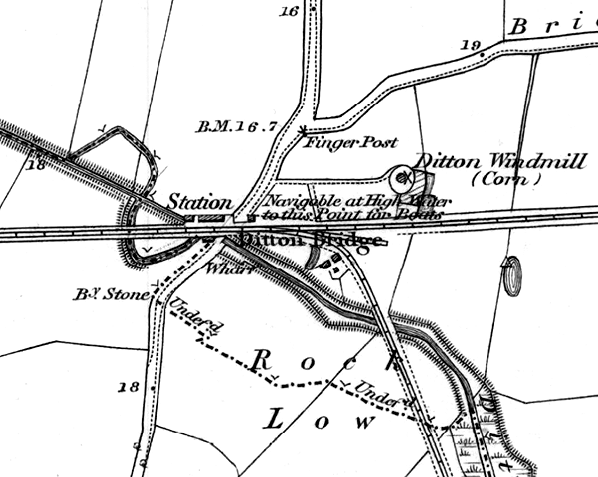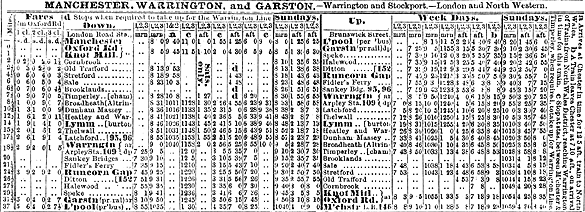Notes: Ditton Mill station was situated on the Garston and Warrington railway which was opened in two stages: between Runcorn Gap (Widnes) and Garston on 1 July 1852, and between Runcorn Gap and Warrington on 1 February 1853, by the St Helens Canal & Railway Company (SHC&RC). By 1 May 1854 a connection with the Warrington & Stockport Railway (W&S) at Warrington Arpley was made, creating a through route between Garston and the Manchester area.
Ditton Mill station opened as a temporary terminus on 21 May 1851. The line from Widnes to Ditton Mill had been completed, and the SHC&RC was keen to earn revenue from it whilst construction towards Garston was still in progress. Through services to and from Garston began on 1 July 1852.
The station was on the east side of Ditton Brook over which the double-track line passed on a bridge. The station was named after a nearby windmill. In the 1850s the area around the station was rural and sparsely populated.
There are no known pictures of Ditton Mill station, but it is likely that it consisted of two platforms with a basic cottage-style booking office and waiting room.
By 1854 Ditton Mill was being served by trains running between St Helens and Garston Dock and between Warrington and Garston Dock. In March 1858 the Great Northern Railway (GNR) started a service between Garston Dock and London Kings Cross. It is unlikely that these trains called at Ditton Mill.
On 1 September 1860 the London & North Western Railway (LNWR) took out a lease on the Garston and Warrington line and started to run the train services along it. The 1863 timetable showed Ditton Mill as having six trains in each direction Monday-to-Saturday and three each way on Sundays. On 1 September 1864 the LNWR absorbed the line completely. On 15 February 1864 a connection had opened between Speke (just to the east of Garston) and Edge Hill which provided access to the LNWR main line station at Liverpool Lime Street. The new line was crucial to the LNWR’s ambition of creating a shorter route between Liverpool and London.
In 1861 the LNWR had obtained an Act to build a new line from Ditton to a point just north of the River Weaver (at what became Weaver Junction) on their existing main line to London. The line had to climb steeply from Ditton so that it could cross the River Mersey at Runcorn Gap, with a 75ft clearance at high tide to allow ships to pass beneath.
Work on the new line commenced in 1863, and there must have been some disruption at Ditton Mill as the embankment carrying the new line towards the river was located immediately south of the station. The junction between the Weaver Junction line and the Garston and Warrington route was located to the west of Ditton Mill station and west of Ditton Brook. The new line opened to goods services on 1 February 1869 and to passengers on 1 April 1869.
Ditton Mill station was of no use to trains running along what became a busy trunk route between Liverpool and the south as it was located to the east of the junction at Ditton on the Garston and Warrington line; it was also unable to offer interchange opportunities. The LNWR recognised this and built a new station to the west of the junction called Ditton Junction. The new station opened on 1 May 1871 and Ditton Mill was closed. It was demolished after closure, leaving no trace.
Over the following decades Ditton Junction developed into a large and complex railway location with many industries located adjacent to it. On the north side of the station site a large timber yard was established with its own sidings, some of which occupied the site of the up platform.
On 2 February 1885 two additional lines were opened between Widnes and Ditton Junction. Designated the up and down goods lines, they ran to the south of the Weaver Junction line and then burrowed underneath it to join the Garston and Warrington route.
The course of the original route of the Garston and Warrington railway through the site of Ditton Mill closed completely between Ditton Junction and Widnes West Deviation Junction on 14 February 1966, the track being lifted almost immediately. From that date all traffic running between Ditton and Warrington has used the 1885 goods lines.
The 8D Association - Dedicated to promoting the history of South Lancashire and North Cheshire railways. Web Site
Ticket from Michael Stewart, timetable from Paul Wright and route map by Alan Young.
Sources:
- The St Helens Railway, Its Rivals and Successors – J M Tolston – The Oakwood Press 1982.
- Bradshaw Timetable December 1895.
- Bradshaw Timetable July 1922.
- LMS Timetable Summer 1932.
- BR (LMR) Timetable May - Sept 1948.
To see other stations on the Garston and Warrington Railway click on the station name: Garston Dock, Church Road, Speke, Halebank, Ditton,
Widnes, Widnes South, Cuerdley, Fidlers Ferry & Penketh, Sankey Bridges,
Warrington Bank Quay Low Level and Warrington Arpley
See also Warrington & Stockport Railway stations: Latchford, Thelwall, Lymm, Dunham Massey and Broadheath
See also Sutton Weaver on the Ditton and Weaver Junction line.
See feature: The Ethelfleda Bridge |

mill_old1.jpg)

 Ditton Mill station shown on a six-inch scale map from the early 1850s. The branch seen running off to the south served the Ditton Marsh Ironworks.
Ditton Mill station shown on a six-inch scale map from the early 1850s. The branch seen running off to the south served the Ditton Marsh Ironworks. 
.jpg)
.jpg)
.jpg)



 Home Page
Home Page